When is Tihar Celebrated in 2025?
In 2025, Tihar falls between October 19 and October 23 according to the Nepali lunar calendar. Usually, there are separate day to worship dog and goddess of wealth but this year, it has fall on the same day make Tihar 4 distinct days holding special meaning.
Here are the dates for each day for 2025:
- Kaag Tihar (Crow Worshipping Day): October 19, 2025 (Sunday)
- Kukur Tihar/ Laxmi Puja: October 20, 2025 (Monday)
- Govardhan Puja / Mha Puja/ Goru Puja: October 22, 2025 (Wednesday)
- Bhai Tika: October 23, 2025 (Thursday): Auspicious time for bhai tika 2025 is 11:39 AM.
This five-day sequence beautifully intertwines devotion, nature, and celebration each day carrying its own charm and ritual significance.
Five Days of Tihar: Rituals and Cultural Importance
Day 1: Kaag Tihar - Day to Worship Crows
Kaag Tihar marks the first day of Tihar which is dedicated to crow (Kaag). Crows are considered as worshipped because they are believed to be the messenger of Yamaraj (the god of death).
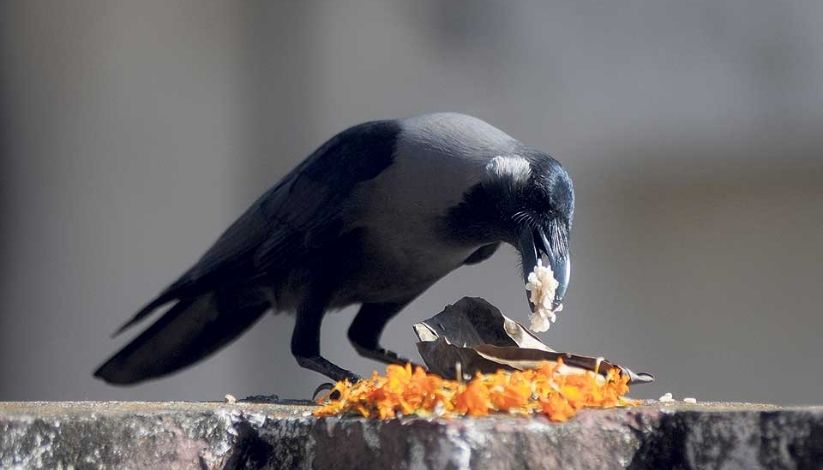
On this day, people make puja to crows, by offering them food, grains, sweets, gardlands and tika (vermilion) early in the morning. This ritual is meant to protect from bad luck and sadness. By praying and feeding the crows, people hope to receive good news and blessing for the whole year.
The sight of crows flying over sunlit rooftops, surrounded by the aroma of freshly prepared food, marks the peaceful beginning of this auspicious festival. This year in 2025, Kaag Tihar falls on 19th of October.
Day 2: Kukur Tihar - Worship of the Dog
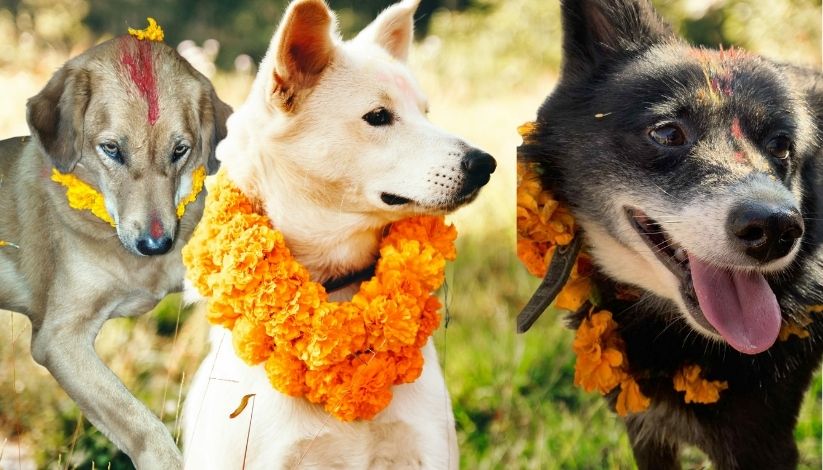
Now comes the second day of tihar, which is called Kukur Tihar, the most beloved part of the Tihar. On this day, dogs are worshipped to honour their heir loyalty, friendship, and protection they provide to humans. Both pets and stray dogs are worshipped equllay on this day as they are believed to be the guards of heaven and accompany 'Yamaraj', the god of death.
Nepali people worship dogs by offering flower garland also known as mala around their neck, auspicious vermilion on their forehead as shown in the picture above. After the puja people provide them treats like selroti, meat, eggs and so on. Across Nepal, dogs are often seen decorated with bright garlands, their wagging tails adding to the festive spirit.
In addition to being a religious believe, Kukur Tihar serves as a compassionate reminder to cherish and adore all living things. It has also drawn international attention in recent years for encouraging compassion and animal welfare.
Day 3: Laxmi Puja and Gai Tihar – Worship of the Cow and Goddess of Wealth
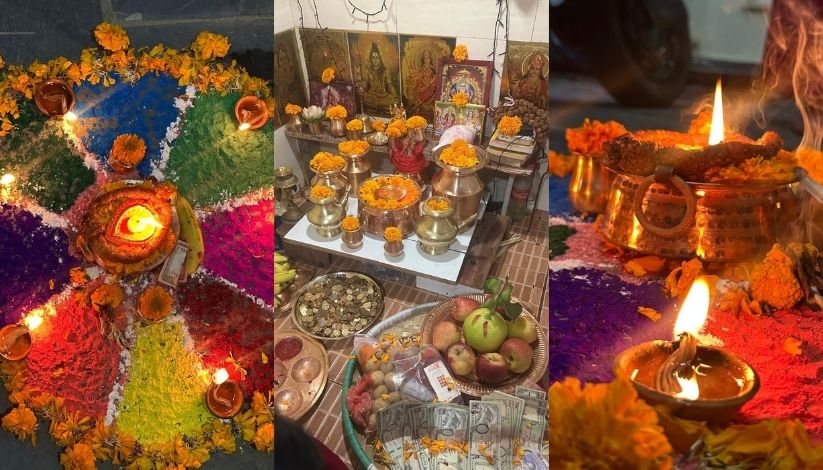
The third day of Tihar, Gai Tihar, is the most significant and festive. On this day they will start worshipping the cow (gai), everyone’s out there pampering cows like they’re actual royalty. And why not? - cows are the national animal of Nepal and they symbolize prosperity and motherhood. Similar to dogs on Kukur Tihar, cows are worshipped using vermilion on their forehead, garland around the neck and they are offered VIP breakfast: grass, fruits, grains and so on.
By the time evening rolls around, its Laxmi Puja time, and the whole vibe is about fortune and good luck. Every single house, shop, you name it, they’re scrubbing, sweeping, cleaning like their lives depend on it. And then the colorful lights come out. Oil lamps, candles, fairy lights, you can barely see the street for all the glows. People make beautiful rangoli at their doors, using colored powder or rice or whatever looks pretty, just hoping to welcome in good Goddess Laxmi and her blessings.
Kids and teenagers start going door to door performing Duesi and Bhailo, basically dancing, singing traditional songs spreading joy and receiving money, selroti, and fruits. These lively traditions bring neighborhoods together, filling the air with music, laughter, and unity.
Day 4: Govardhan Puja, Mha Puja, and Ox Worship
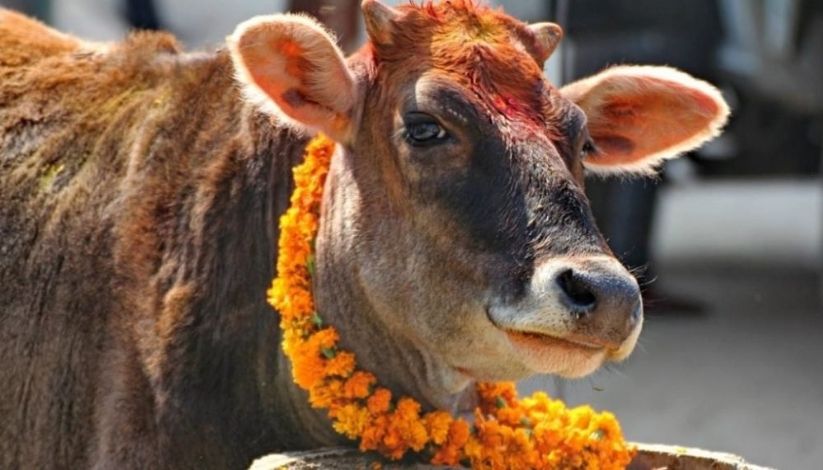
Significant regional and cultural variations can be seen throughout Nepal on the fourth day of Tihar. Govardhan Puja, which honors the story of Lord Krishna raising Govardhan Hill to protect villages from a terrible storm, is observed on this day by many Hindus. Participants in this ritual build little mounds of cow dung to represent the hill, which they then decorate with flowers and oil candles.
The day is known as Goru Puja among rural communities, and it is devoted to honoring oxen for their vital role in farming. As a token of appreciation for their work in the fields, the oxen are ceremoniously bathed, garlanded, and given special food offerings.
Mha Puja in the Newar community? It’s not just another festival on this day; it’s the beautiful tradition where people basically worship for their own souls. Yeah, it literally means “worship of the self”. It’s all about cleaning out the bad vibes, getting your mojo back, and starting fresh. It also happens to be Newari New Year, according to the Nepal Sambat calendar.
Day 5: Bhai Tika - The Sacred Bond Between Brothers and Sisters
The final day, Bhai Tika, is the emotional highlight of Tihar. On this day, sisters honor their brothers with love, prayers, and blessings. Most importantly they pray for their safety, good health and longevity.
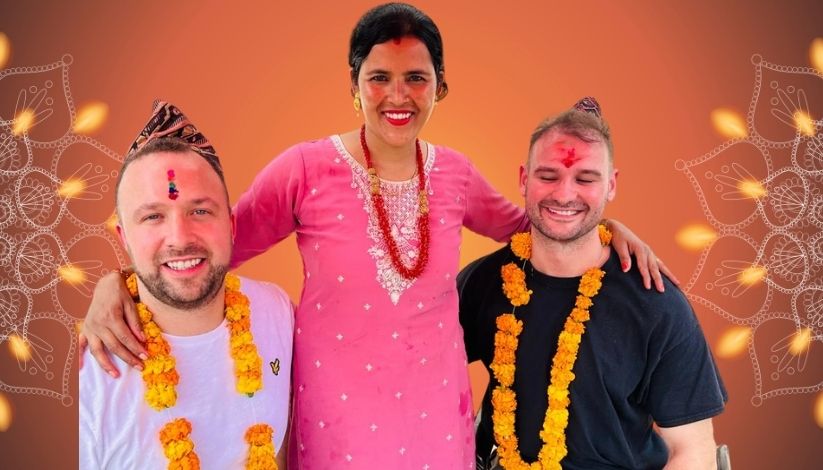
Sisters apply Saptarangi Tika (a seven-colored tika) on their brothers’ foreheads, offer garlands of flowers, and serve traditional foods and sweets.
In return, brothers offers gifts or dakshina (money) and promise to protect their sisters as well. The ceremony represents deep affection, protection, and respect among siblings. Even those without siblings often celebrate with cousins or close friends, symbolizing love beyond blood relations.
It is believed that this tradition started when Yamuna the sister of Yama performed a ritual to protect her brother from death. So, Yama stated that whoever received Bhai Tika would not die on that day. The ritual continues as a celebration of eternal love between brother and sister.
According to Nepal Panchanga Nirnayak Samiti, the auspicious tika time for Bhai Tika 2025 is 11:39 AM (Nepali time), on 23rd October 2025. This time is called BhaiTika Sahit.
Customs and Festivities That Light Up Nepal
Lighting and Decorations
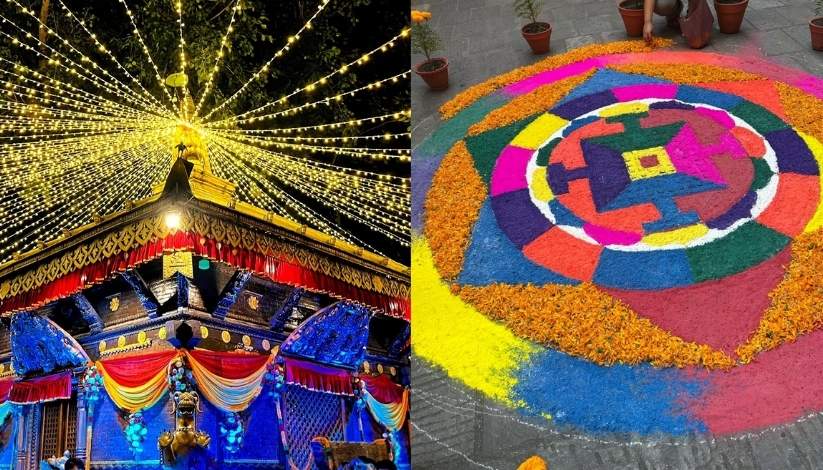
During Tihar, every corner of Nepal glows. Whether it is village or city, homes, temples, and streets are filled with oil lamps, candles, and sparkling lights. People also decorate their doorways with marigold garlands and colorful rangolis. The fragrance of flowers and the soft glow of lamps create a magical ambiance, turning entire towns into dazzling works of art.
Deusi and Bhailo: Songs of Celebration
Deusi and Bhailo are unique traditions that bring music, dance, and laughter to Tihar nights. Groups of young people visit homes singing Deusi and Bhailo joyful folk songs that bless households with prosperity and happiness.
In return, hosts offer them money, fruits, sel roti, and sweets. In the 21st century, these songs often mix traditional verses with modern humor and creativity, keeping the festive spirit alive across generations.
Festive Foods of Tihar
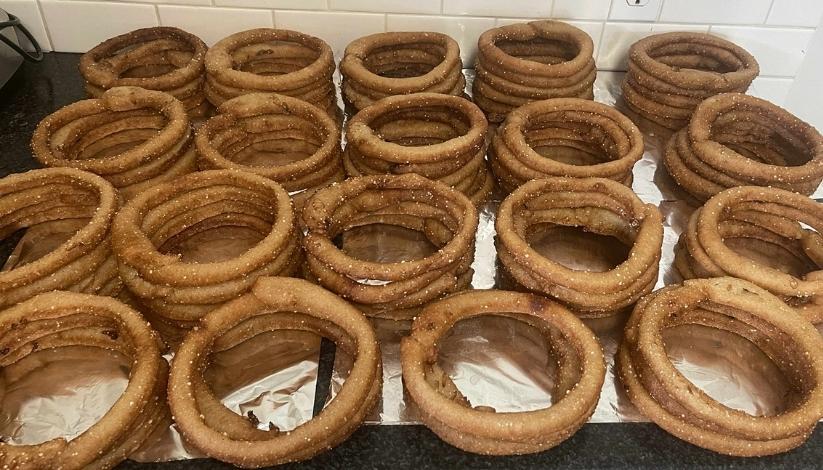
Tihar is also a festival of delicious traditional foods. Families prepare and share a variety of dishes such as:
- Sel Roti: A sweet, ring-shaped bread made from rice flour, deep-fried until crispy as shown in the picture above.
- Anarasa: A rice-based sweet flavored similar to selroti but with ghee and sesame seeds.
- Fruits and Dry Nuts: Offered during pujas and shared among family members.
- Homemade sweets, puris, and curries: Prepared for guests and family gatherings.
Symbolism in Every Ritual
Each day of Tihar symbolizes different things. They are:
- Kaag Tihar: Respect for communication and vigilance.
- Kukur Tihar: Loyalty and unconditional love.
- Gai Tihar: Prosperity and gratitude.
- Laxmi Puja: Wealth and purity.
- Mha Puja: Self-awareness and harmony.
- Bhai Tika: Family bonds and protection.
Together, these symbolize the Nepali philosophy that life is sacred in all its forms - from animals and nature to the divine and human connections.
Experiencing Tihar as a Traveler in Nepal
Tihar festival is one of the best times to visit Nepal for travelers seeking both cultural immersion and festive beauty. The weather in late October is pleasant clear skies, mild temperatures, and panoramic mountain views.
If you’re in Kathmandu, visit areas like Patan Durbar Square, Bhaktapur, and Thamel, where lights and music bring ancient cities to life. In Pokhara, the reflection of festival lights on Phewa Lake creates an unforgettable sight.
Trekking routes such as the Everest Base Camp, Annapurna Circuit, and Langtang Valley remain open during Tihar. Tea houses and lodges celebrate in their own way lighting lamps and serving festive meals. It’s a wonderful time to experience both Nepal’s natural beauty and its living traditions.
Is Diwali and Tihar same?
Though Tihar in Nepal and Diwali in India share common roots, as both of them are festival of light and to worship goddess laxmi, they are different. Tihar stands out for its five-day celebration of animals and personal rituals like Mha Puja and Bhai Tika.
While, the main theme of Diwali is celebration of return of Lord Ram, Tihar focuses on harmony among humans, animals gods, and nature. This blend of spirituality and culture makes Tihar distinct and deeply meaningful.
How Travelers Can Participate Respectfully
If you are in Nepal during Tihar, you can can also join in the celebrations:
- Light diyas at your guesthouse or home.
- Watch or participate in Deusi-Bhailo performances and participate in it.
- Taste homemade sel roti and sweets.
- Visit temples and heritage sites decorated with lights.
- Be kind to animals - feed dogs or birds.
- Respect private rituals like Bhai Tika. If they invite you to join, you can experience the culture.
Conclusion: The Light That Connects All
Tihar is not just a festival, it’s a reminder of how lives interconnected. Worshipping animals like dogs, cow, ox and birds decapitates the co-existence of lives. Rituals done on each day tells a story of gratitude and harmony.
The flickering lights of Tihar reflect the soul of Nepal - warm, welcoming, and wise. Whether you come to trek its mountains or explore its ancient cities, experiencing Tihar will give you a deeper understanding of Nepali culture and spirituality.













